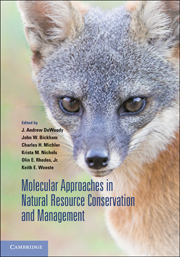Book contents
- Frontmatter
- Contents
- Contributors
- Preface
- 1 Biodiversity discovery and its importance to conservation
- 2 Gene flow, biodiversity, and genetically modified crops: Weedy rice in Thailand
- 3 A community and ecosystem genetics approach to conservation biology and management
- 4 Vertebrate sex-determining genes and their potential utility in conservation, with particular emphasis on fishes
- 5 Historical and contemporary dynamics of adaptive differentiation in European oaks
- 6 Association genetics, population genomics, and conservation: Revealing the genes underlying adaptation in natural populations of plants and animals
- 7 Hybridization in threatened and endangered animal taxa: Implications for conservation and management of biodiversity
- 8 Pollen and seed movement in disturbed tropical landscapes
- 9 Implications of landscape alteration for the conservation of genetic diversity of endangered species
- 10 Integrating evolutionary considerations into recovery planning for Pacific salmon
- 11 Using molecular methods to improve the genetic management of captive breeding programs for threatened species
- 12 Wildlife reintroductions: The conceptual development and application of theory
- 13 Evolutionary toxicology
- Index
- Plates
- References
Preface
Published online by Cambridge University Press: 05 July 2014
- Frontmatter
- Contents
- Contributors
- Preface
- 1 Biodiversity discovery and its importance to conservation
- 2 Gene flow, biodiversity, and genetically modified crops: Weedy rice in Thailand
- 3 A community and ecosystem genetics approach to conservation biology and management
- 4 Vertebrate sex-determining genes and their potential utility in conservation, with particular emphasis on fishes
- 5 Historical and contemporary dynamics of adaptive differentiation in European oaks
- 6 Association genetics, population genomics, and conservation: Revealing the genes underlying adaptation in natural populations of plants and animals
- 7 Hybridization in threatened and endangered animal taxa: Implications for conservation and management of biodiversity
- 8 Pollen and seed movement in disturbed tropical landscapes
- 9 Implications of landscape alteration for the conservation of genetic diversity of endangered species
- 10 Integrating evolutionary considerations into recovery planning for Pacific salmon
- 11 Using molecular methods to improve the genetic management of captive breeding programs for threatened species
- 12 Wildlife reintroductions: The conceptual development and application of theory
- 13 Evolutionary toxicology
- Index
- Plates
- References
Summary
The world would be a wonderful place if our natural resources (e.g., forests, fish, and wildlife) needed no management and conservation was not a concern. In a world with a global human population approaching 7 billion and where most developed nations overconsume these resources, however, conservation is a concern and management is necessary for sustainable use. Historically, natural resource management strategies were determined by the collection and interpretation of basic field data. Today, as challenges to the sustainability and conservation of our natural resources arise, managers often need data that cannot be acquired using conventional methods. For example, a natural resource manager might want to know the number of successful breeders in a population or if genetic variation was being depleted because of a management practice. Traditional field craft alone cannot directly address such questions, but the answers can be determined with some precision if the field work is coupled with modern molecular genetic techniques.
Molecules can enlighten us about biological attributes that are virtually impossible to observe in the field (Avise 2004). Parentage analysis is one such arena in which genetic data can inform management practices (DeWoody 2005), but there are a host of others. For example, molecular data have revealed deep evolutionary splits in stocks at one time thought to be homogeneous. This finding has concomitant management implications (Hoffman et al. 2006). Similarly, molecules can enlighten us about biologies that are virtually impossible to observe in the field, such as pollen flow (Hamrick, this volume) or the physiology of migration (Nichols et al. 2008).
- Type
- Chapter
- Information
- Molecular Approaches in Natural Resource Conservation and Management , pp. xv - xviiiPublisher: Cambridge University PressPrint publication year: 2010



